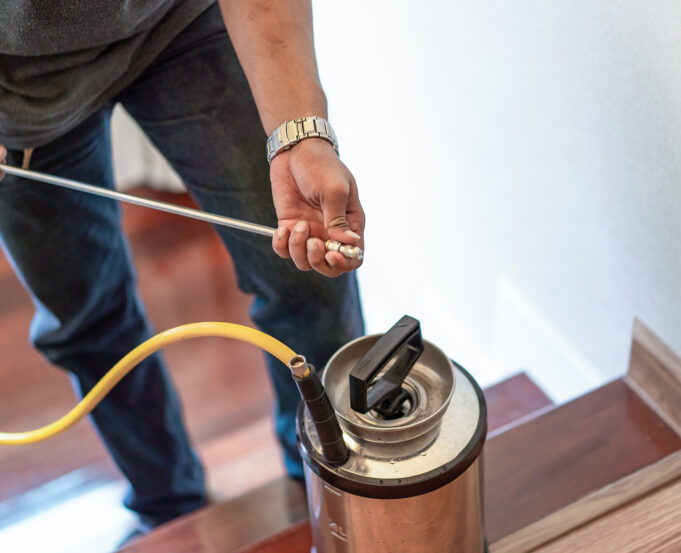Written by Condo Control Central Blog
What do termites, cockroaches and rats have in common? Other than being very unpopular creatures, they have all found their way into people’s homes.
These pests are more than just a nuisance if they’ve gotten comfortable in your kitchen or behind your couch. Single-family homes and condos can become infested with these bugs and rodents, and that can lead to serious property or health issues.
In most cases, owners will take the appropriate steps to ensure the pests are terminated/removed as soon as possible. But those who live in condos or HOAs may wonder about who is responsible for pest control.
Types of infestations
Before we address this answer, it’s helpful to know about different types of infestations. Some are more obvious than others, but they all need to be dealt with. Unfortunately, when pests find a place they like, they’re probably not going to leave on their own. In fact, more and more of them show up as time goes on.
In single-family homes, residents have had to deal with squirrels, rats, raccoons, termites, and cockroaches. Some communities have even reported rabbit infestations, which can cause serious damage to landscaping.
Cockroaches, ants, mice or rats, bedbugs and termites have all been found guilty of infesting condo buildings. These pests can be harder to get rid of because they are so small. Moreover, they may spread to other units in the building.
Who pays for pest control? The answer isn’t always simple
Generally speaking, if a common area is overrun with pests, then the corporation or association pays for the costs to remove the bugs/animals. Keep in mind that the money is still coming from fees paid by the members of the community. If an individual home has pests, and the outbreak cannot be traced back to a common area within the development, then it is up to the owner to pay for a service provider.
However, condos and HOAs may struggle to come to an agreement about who pays for pest control. Even if the corporation or association has written rules about pest control responsibilities, the circumstances that lead to the infestation can vary, making it difficult to say for sure who must pay for pest control services.
Some states and provinces have basic laws about pest control, but they are not often detailed enough to prevent disagreements between the community and individual owners. For example, what if mice entered through a common area but ended up in a condo unit? These types of situations can be tricky to resolve.
In cases where residents are responsible for infestations, the property manager or board must practice accurate and thorough documentation. Treat the issue like you would any other violation . The resident must also receive proper notice to the resident about the issue, and when it must be resolved. Should the resident refuse to stop the behaviour that caused the infestation, or fail to call a professional to get rid of the pests, then the board may have to take legal action.
Condo communities
There is a risk of infestations spreading between condo units since neighbours live so close together. Therefore, condos are granted certain powers to promptly address this issue. In Ontario, under section 58 of the Condominium Act , 1998, condo corporations can adopt rules to:
Promote the safety, security, or welfare of the owners and of the property Prevent unreasonable interference with the use and enjoyment of the units or common elements of the corporation
As such, condo corporations will often have rules that:
Require owners and residents to take reasonable steps to prevent infestations in their unit and the common elements Require owners and residents to take immediate action to address an infestation Prohibit certain activities that could promote infestations
In Massachusetts, it is suggested that an association should handle common areas, and could treat units if pests made it past common areas, but the unit owners would ultimately be responsible for exterminating within their homes.
California Civil Code Section 1364 states that “as defined in Section 1351, unless otherwise provided in the declaration, the association is responsible for the repair and maintenance of the common area occasioned by the presence of wood-destroying pests or organisms.”
in a community apartment project, condominium project, or stock cooperative, unless otherwise provided in the declaration, the association is responsible for the repair and maintenance of the common area occasioned by the presence of wood-destroying pests or organisms.
As you can see, many laws are not detailed enough to settle every situation. Many corporations/associations have provisions in their own governing documents that address infestation so that problems are easier to resolve.
When it comes to pests, fault is difficult to assign. If there is a building-wide infestation, then it would be impossible to determine the source, and the condo would most likely be expected to pay for all costs. In less extreme situations, the board might consider splitting costs with residents if units on a single floor have become infested.
Single-family homes
Owners who live in houses will likely have to pay out of pocket if their properties become infested. That’s because they are responsible for maintaining the inside and outside of their homes (in most cases).
Returning to the California Civil Code Section 1364, unless the association’s governing documents say otherwise, the association must cover the cost of repairs and maintenance of common areas, other than exclusive use common areas. The owner of each separate interest is responsible for maintaining their home and any exclusive use common area appurtenant to the separate interest.
But, if a majority of owners vote to change this, “then the responsibility for such repair and maintenance may be delegated to the association, which shall be entitled to recover the cost thereof as a special assessment.”
Some HOAs will state in their governing laws that whoever causes the infestation will be responsible for all associated pest management costs. In these cases, there must be proper documentation available to clearly prove fault (and as mentioned earlier, that can be very hard to do).
Can residents deny an exterminator entry to their homes?
If a home or unit is clearly the source of the infestation, but the resident refuses to do anything about it, then the corporation/association may have the ability to send an exterminator in and charge costs back to the resident. This is possible because the infestation has the potential to harm other residents or property that does not belong to the resident.
Where you live will determine what powers your community has, but it’s best not to try and force a resident to accept service. Instead, the board is advised to seek legal assistance.
In Illinois, owners have no right to bar an HOA from entering their unit for pest extermination. However, the resident must have received reasonable notice beforehand.
In Colorado, the matter is more complex. For single-family houses and townhomes, the law says associations do not possess the right to enter units. But condo associations can be granted an easement to enter units for the purpose of handling pests. Should a resident refuse, the association can obtain a court order and charge legal costs to the resident.
If the condo or HOA is unsure how to handle a situation where a resident won’t do anything to remove the pests from their unit, consult with a lawyer first.
Tips for minimizing infestations
Corporations/associations can use and share these tips with residents to minimize pest infestations. If your community is aware of a good vendor, you can also make their contact information available.
Dispose of trash properly. HOA members may even be required to keep garbage cans locked away from squirrels and raccoons Store food securely. Don’t leave bags of food open Patch up all entry and exit holes. If you see holes or cracks in common areas, submit a service request and report the issue Deep clean your home annually. You might be surprised what’s fallen underneath the fridge or stove Tidy your home regularly Call a professional if you cannot handle the pests yourself
Shared from Condo Control Central Blog











